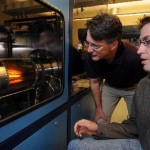Jul
25
A Way to An Affordable LED Lamp
July 25, 2008 | 7 Comments
At this moment LEDs are far more expensive than the compact florescent lamp. The efficiency is similar, but the LED should be much more compact and able to fill many more specialized roles. So when Purdue’s Timothy D. Sands, Professor of Materials Engineering and Electrical and Computer Engineering has a paper appearing in the journal Applied Physics Letters from the American Institute of Physics, its time to take note.
LEDs and CFLs offer an opportunity to reduce electrical generating demand by 10% an equivalent to 20% of the coal fired power generation. It can be very significant with wide adoption. That’s why the LED breakthrough that Professor Sands is announcing is so important. Another way to look at it is the reduction would allow power generation fuels to provide as much as a third of the recharge needs for electric vehicles. Little numbers of huge amounts really are significant.
The Purdue team’s innovation is to substitute the first layer of substrate, the building base of an LED, from rare and expensive sapphire to the low cost metal-coated silicon wafer. Another reason the sapphire based build of LEDs is so expensive is they need a reflector, or a mirror to direct the light out where needed instead of being absorbed back into the base. The Purdue team’s design addresses this issue with a “metallized” silicon substrate that has a built on reflective layer of zirconium nitride. The research has solved the problem of zirconium nitride becoming unstable in the presence of silicon, or removed the reactive effect by placed a layer of aluminum nitride between them.
The advance offers manufacturers a process path that uses a common process called reactive sputter deposition. The method bombards the metals with positive charged ions of argon gas in a vacuum. The argon causes the metal atoms to be ejected and nitrogen then reacts depositing first the aluminum nitride, the zirconium nitride and finally the gallium nitride is added by another common technique called organometallic vapor phase epitaxy. The result is a neatly laid out crystalline structure matching the underlying silicon.
The crystalline structure is a critical for efficient performance. Using silicon wafers enables massive scale up as many LEDs can be built up as a group. Silicon also dissipates the heat better than sapphire, reducing heat cycling damage, extending LED lifetime and reliability.
CFLs are currently leading the market, but the size, bulk and fragile mercury containing attributes offer opportunities for better products. White light LEDs have been tested ranging from 47 to 64% efficient and are expected to better CFLs soon. The Purdue team’s contribution should go a long way to solving the LEDs huge price disadvantage.
Sands offers that two hurdles remain, the minimization of defective units during manufacture and the matter of the metallic crystals cracking as the whole unit cools down after the build up. “These are engineering issues, not major show stoppers,” Sands said. “The major obstacle was coming up with a substrate based on silicon that also has a reflective surface underneath the epitaxial gallium nitride layer, and we have now solved this problem.”
The Applied Physics Letters paper was written by the researcher team in the School of Materials Engineering and the School of Electrical and Computer Engineering: Oliver; fellow graduate students Jeremy L. Schroeder, David A. Ewoldt, Isaac H. Wildeson, Robert Colby, Patrick R. Cantwell and Vijay Rawat; Eric A. Stach, an associate professor of materials engineering; and Sands.
And as a marvelous courtesy, an electronic copy of the research paper is available from Emil Venere, Purdue News Service, at (765) 494-4709, venere@purdue.edu
A good job and thanks for the access to the paper.
Comments
7 Comments so far




[…] (OLEDs) available in Nature Photonics. Like the semiconductor light emitting diodes (SLEDs) from Purdue’s researchers we looked at last week these scientists are driving to a highly efficient LED based on the organic materials for […]
we are manufacturer of led lamps. the led lamps is not so expensive as 2008. large quantity of production and more and more application made the average cost lower. if you interested in communicate with me, please view our website http://www.theledlight.com.cn or email info@theledlight.com.cn
Linda
We are a professional manufacturer that produce the led display, led panel light ,led tube and other led components.
I was just having a conversation over this I am glad I came across this it cleared some of the questions I had.
Intriguing post. I have been searching for some good resources for solar panels and discovered your blog. Planning to bookmark this one!
Hello, this is my first time i visit here. I found so many interesting in your blog especially on how to determine the topic. keep up the good work.
I’ve been exploring for a little for any high-quality articles or blog posts on this kind of area . Exploring in Yahoo I at last stumbled upon this site. Reading this information So i’m happy to convey that I have an incredibly good uncanny feeling I discovered exactly what I needed. I most certainly will make certain to do not forget this site and give it a look regularly.